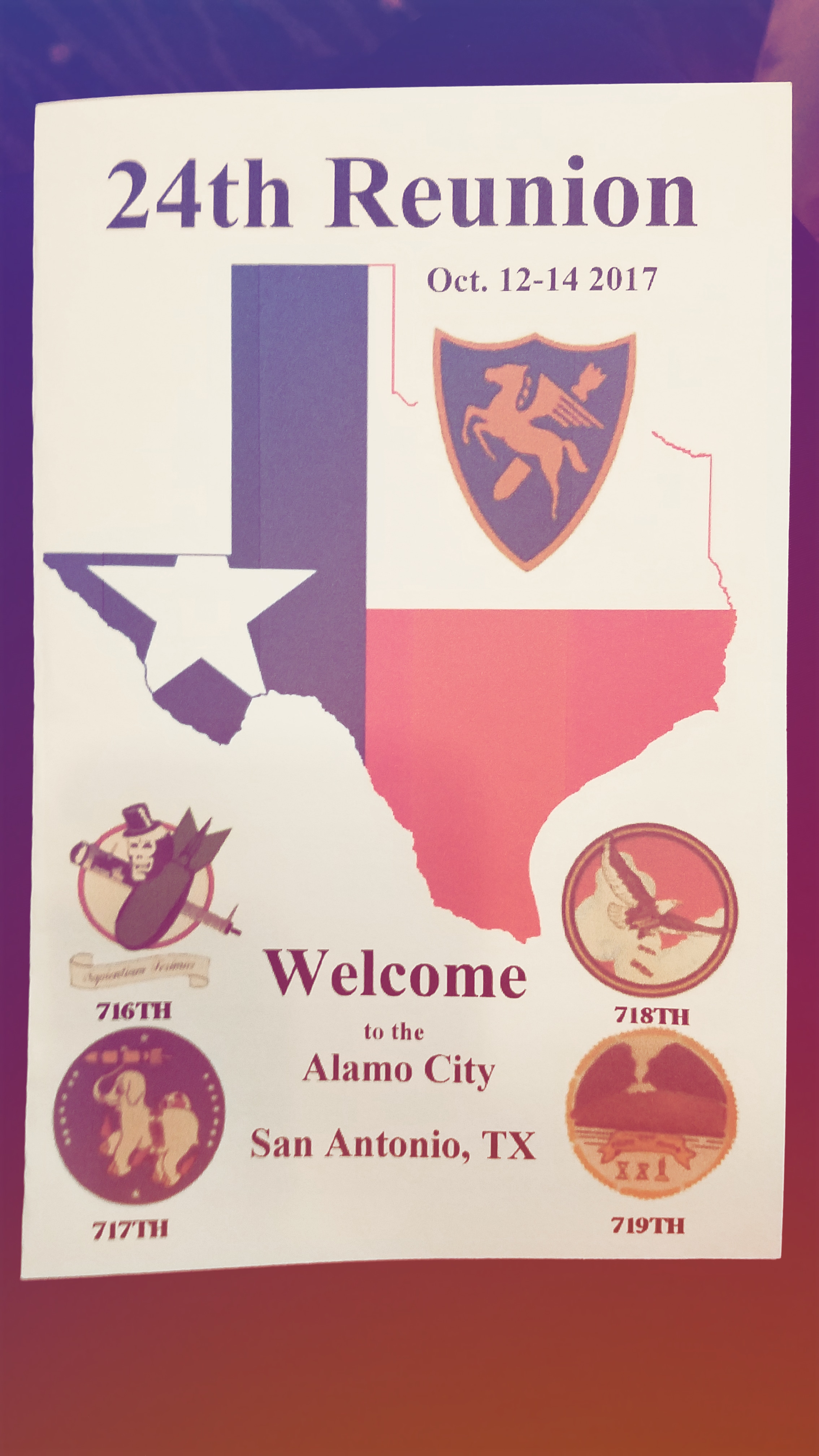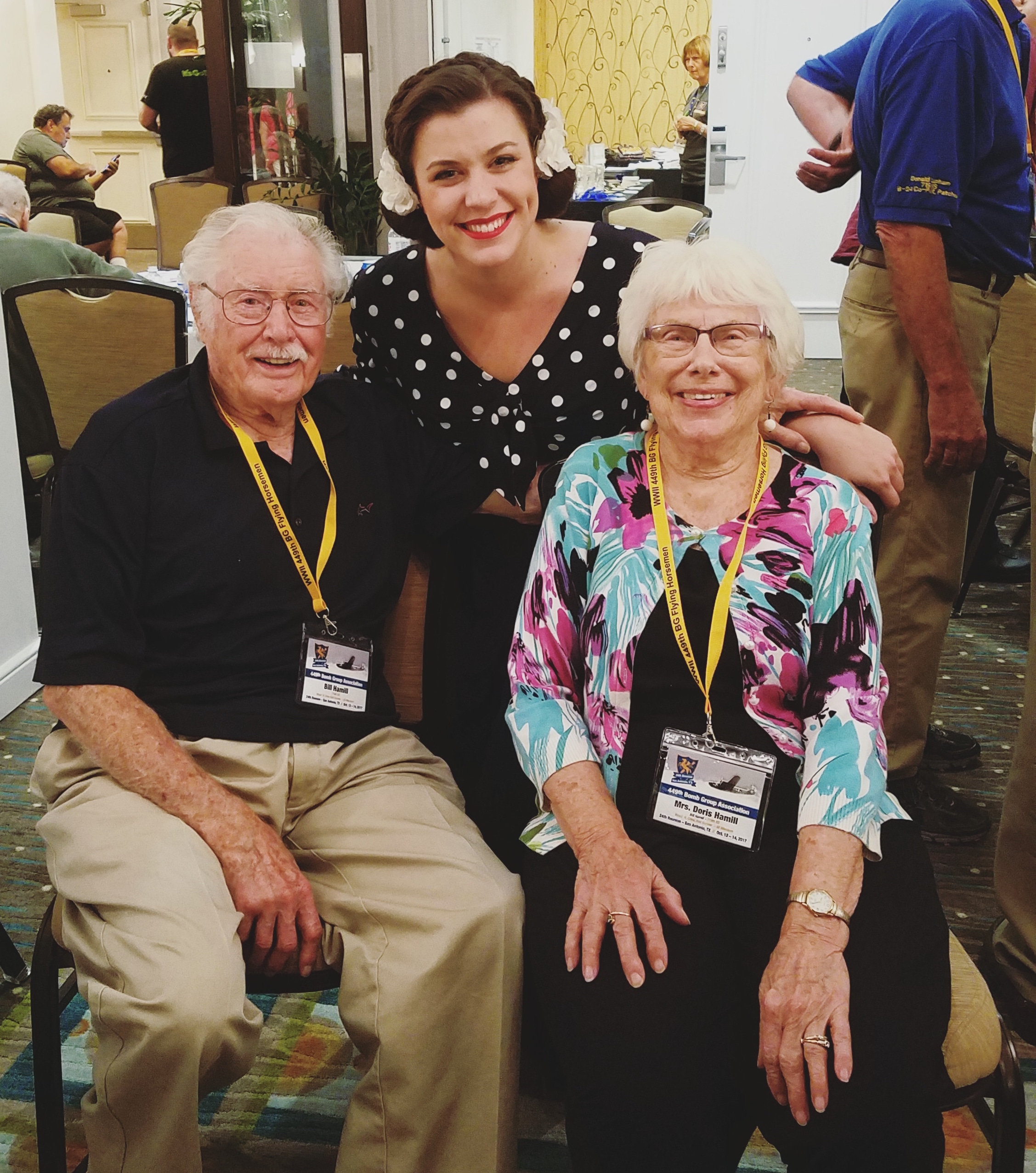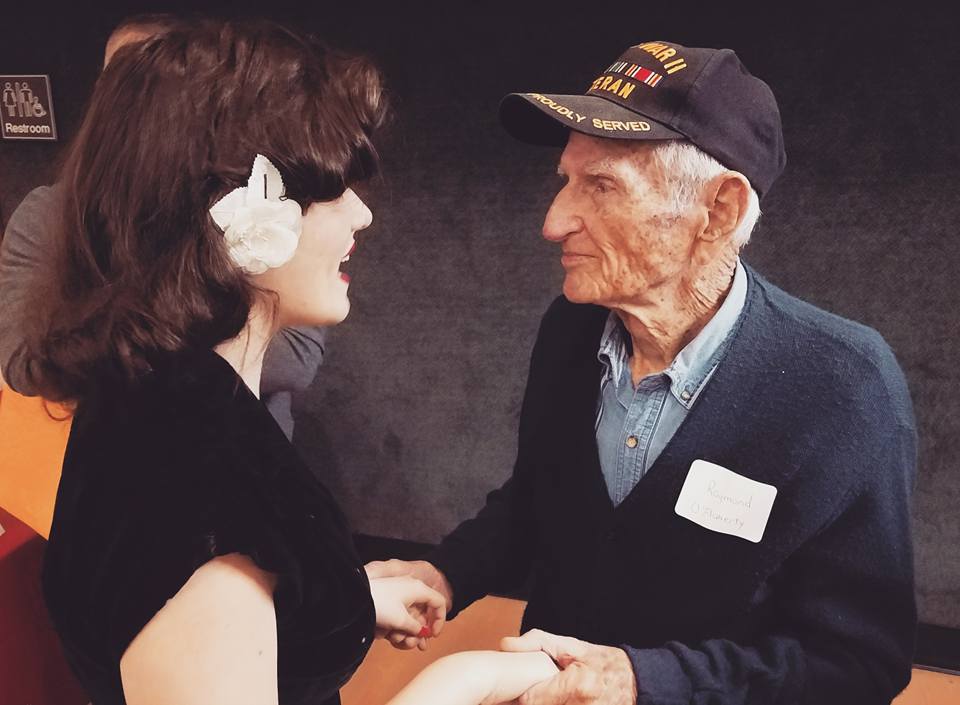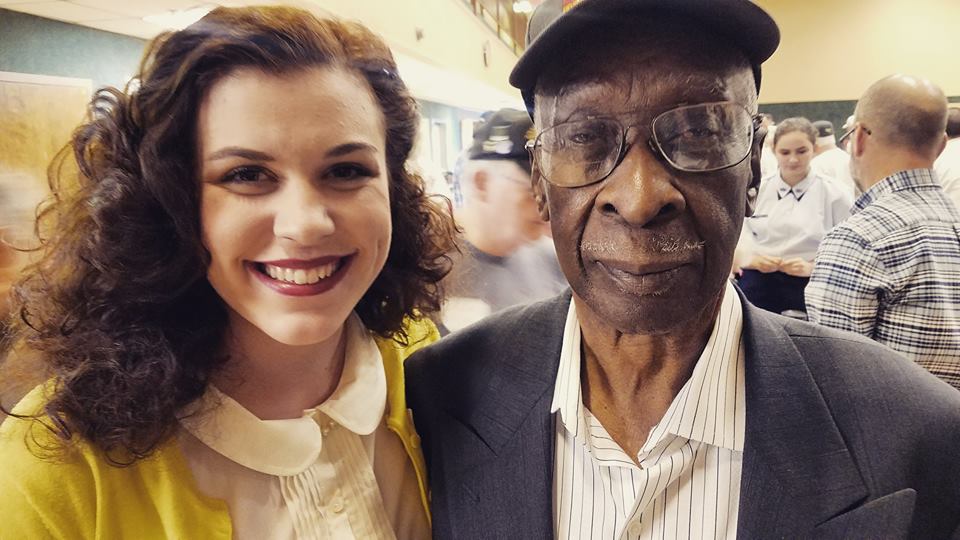Unpublished Highlights from 2017
/Well, we've reached the end of 2017. And what a year it's been. There have been a lot of bittersweet emotions throughout the year as we closed out our third year with Operation Meatball and started into our 4th. Over the last few months we've undergone some changes which I'll go into later. However, with all the blessings intermixed with sadness, defeats, and victories, we can truly look back on 2017 as a blessed/successful one.
I initially wanted to write an in-deph review of the year, as we did in 2016. However, time does not allow, and quite truthfully, I don't want to try your patience to the breaking. Instead, I offer you highlights from some of our un-blogged about events this past year.
My Favorite Professor
In April, after 2+ years, I was reunited with one of my wonderful Iwo Jima veterans (and all around favorite professors), Mr. Bill P.
Mr. P. and I first met on Guam in 2015, during the 70th anniversary of Iwo Jima. We hit it off right away as we chatted about history, education, politics, and how it relates to us today. I was particularly struck at the time with the foresight and wisdom he had had as a young Marine to make certain decisions that would completely shape his life and future for the very best.
He retired from Texas Tech before I was in grade school. Now, in his own methodical way and soft Bronx, NY accent, he teaches with a wisdom collected from 93 years of life experience, captivating the listener and leaving him wanting more. I've often told him that if I could have picked a favorite professor to study under, he would have been No. 1.
It was just great getting to visit with him and have our conversation pick up where it had left off on Guam, 2+ years before. He even showed me the 92 textbooks he'd written over his life-time, 5 of which received Texty Awards. I'll never look at another textbook the same again.
The Flying Horsemen Come to San Antonio
In October, San Antonio was invaded by the extraordinary Flyboys and family members of the 449th Bomb Group Association, the Flying Horsemen. And what a terrific invasion it was! By the very kind invitation of the association, Faith and I spent 3 memorable evenings with them, getting a first-hand, crash course history lesson on the Flying Horsemen.
Between January 8, 1944 and April 26, 1945, the 449th Bomb Group flew over 250 combat missions out of their base in Italy. Their losses were great as their targets were often the most heavily defended ones in Europe. "From the time they arrived in Grottaglie until they departed at the end of the war, the 449th lost a total of 135 aircraft. Of those, 111 were lost in combat and 24 were non-combat related losses." (449th Bomb Group Association). But their indomitable spirit persisted, making them "one of the most distinguished and decorated combat units of World War II."
Harvey Gann and his darling wife.
But this indomitable spirit went further than combat missions. Several of the veterans in attendance were ex-POWs. One in particular, a native Texan, Harvey Gann, was captured on January 30, 1944 and sent to Stalag Luft 4 near Grosstychow, Prussia. During his 15 months imprisonment, he attempted escape three times and finally on the fourth attempt, he was successful. However, by the time he arrived safely behind Russian lines, the war was within days of ending. "And to think I could have just waited," he laughingly told me.
Each night there was something special planned for the reunion. The first night was a fun, "Get Acquainted Party." Folks dressed up in the smart styles of the WWII era, there was group singing and a special anniversary cake for Mr. & Mrs. Harvey Gann, who were celebrating 71 years that day.
A little snippet from Squadron Night at the 449th Bomb Group Reunion. Lt. Ed West (B-24 Navigator) & Faith sing, "I left my heart at the Stage Door Canteen." Mr. West has the most remarkable memory for songs, and this was just one of several he sang for us.
The next evening was Squadron Night, a personal favorite for me. This evening was all about celebrating the four squadrons of the 449th Bomb Group: 716th Squadron, 717th Squadron, 718th Squadron, and 719th Squadron. The veterans and family members sat at tables which represented their Squadron, and just like Texans, whenever an opportunity came up to applaud or cheer on the squadron, it was duly taken.
During the evening, there was a terrific panel where each veteran was given an opportunity to share some anecdotes from the war or (in one delightful instance) sing a few wartime songs. This was followed by a fascinating lecture on the Willow Run Factory, a B-24 Bomber manufacturer owned by Ford Motor Company and based out of Michigan during the war. At the peak of her operations in WWII, Willow Run was producing 1 B-24 Liberator per hour! I can honestly say I never thought I would be so interested in a factory, but the history of Willow Run and her current restoration projects blew my mind.
Saturday night, the final banquet was held at the Tower of the Americas, a memorable location to close out the reunion.
As an outsider and onlooker, I have to say how much I loved seeing the enthusiasm and personal pride that was had for each Squadron and the 449th Bomb Group. This wasn't just an annual social get-together. It was a genuine and concerted effort to honor the men of the 449th BG and educate the younger generations on their sacrifices in WWII. Everyone I talked with at the reunion was so knowledgable about the 449th and spoke with such ardor about their relatives that I kept walking away from these conversations greatly moved and motivated to learn more.
The amount of planning and coordination that went into the entire reunion was outstanding. I really must thank the organizers, specifically Denise Reigal, for including us in this special, special reunion. It was such an honor to meet your veterans, listen to their narratives, and even share a few songs with them.
Though the weekend was short, our hearts were quite captured by the Flyboys and family of the 449th Bomb Group.
If you are interested in learning more about the 449th Bomb Group Association, I highly recommend you check out their website. It is full of easily accessible information and content which will keep you reading for hours. I have greatly enjoyed pursuing the articles and documents they have on the website. https://449th.com
The Airborne Demonstration Open Hangar Day
Definitely one of the personal highlights of the year was an impromptu trip up to Oklahoma to see the Airborne Demonstration Team. It happened at the end of October when I was in between events in Fort Worth and discovered my free day happened to align perfectly with the last day of ADT's Jump School and Open Hangar Day. Adding to it, a couple of paratrooper vets I knew were already up there, so naturally I couldn't resist the short trip.
Twice a year, the ADT holds a Parachute Jump School, concluding with their Open Hangar Day and Wing-Pinning ceremony for the students who complete all qualifying jumps. It's quite a thrill to watch the students wings pinned on by WW2 and Korean War airborne veterans. The girls and I attended Open Hangar Day a few years ago and never forgot the experience.
“Our parachute school is a rigorous nine day course located at the historic Frederick Army Airfield in Frederick, Oklahoma. Prior army airborne veterans will tell you to a man that our training is more detailed than what they received at the Army Airborne School. The student is also immersed in an atmosphere of a bustling WWII training facility. Qualifying jumps are made from our two WWII era aircraft, the C-47 Boogie Baby and the C-49 Wild Kat.”
The moment you step back into the hangar it is like going back in time to 1942, as a fly on the wall to one of the greatest creations produced in WWII, the American Paratrooper. The sights, the sounds, the smells, it all reckons back to the era of the WWII paratroopers: Men who were reckless enough to jump out of a plane into combat in the pitch darkness of midnight or broad daylight; and brave enough to take on a half-dozen Germans single-handed. "Any one of us paratroopers was as good as 6 Germans!" An 82nd Airborne vet once told me, "We were the toughest of the tough, and baddest of the bad." (I have to add... they may have once been the toughest of the tough, baddest of the bad, but now, mellowed a bit with years, they can also be called sweetest of the sweet)
It was a wonderful day spent exploring the hangar, watching the students complete their training, and catching up with the vets. Something about the atmosphere of the hangar, an atmosphere so similar to their bootcamp days, brings back old memories to the vets.
Besides being back in the Hangar and catching up with my lovely paratrooper vets, a highlight to the highlights of the day and long-time dream come true was to fly in the C-47, Boogie Baby. But not only fly in a C-47, but go up with one of the "sticks" (groups) making their final qualifying jumps for the ADT Jump School. Truly exhilarating, thrilling, and electrifying are just a few words to describe it.
It wouldn't be complete if I didn't mention my seat-mate during the ride, the fabulous Ms. Mabel. Ms. Mabel is a 90-year old firecracker, full of spunk and energy. From farmer girl to mayor of her town (and a bit of basketball and other athletic sports in between) she has lived life to the max. Today she had come with her husband, a WWII Navy vet, to attend the Open Hangar events and was invited to go up with one of the sticks. Of course she was ecstatic and was bouncing around like a kid the whole way up to the Boogie Baby, and throughout the entire flight she cheered on the fellows about to make their jump, wishing them the very best success. I joked with her that I was sure one of them would be willing to swap spots if she wanted to make the jump too.
It was a whirlwind trip up to Oklahoma, but worth every bit. The folks at ADT are terrific, and the energy and excitement around the hangar is absolutely infectious! It was so good to be back after 2 years. 🇺🇸
More Highlights
As I'm writing this, I'm remembering more and more highlights from 2017, and it's just impossible to include them all. So here are a few more. And maybe someday down the road, I'll have it written up for the blog.
Toccoa Military Weekend
Toccoa Military Weekend. One of my favorite events of the year. This tight-knit community gathers each October to honor the paratroopers who trained at Camp Toccoa during WW2. Making it extra special are the "Original Toccoa Men" who make the trip out each year. Secretly, I think it's just to make sure peeps like us keep running the Currahee mountain (3 Miles Up. 3 Miles Down).
Memorial Day Memories
"A special moment from our friend here, Mr Bordeaux, who told us last month about two friends he grew up with in the late 30s before the war. They were very close, and spend a lot of time together. However, war came and they all enlisted and went their separate directions. Mr. Bordeaux to the Pacific, and Grover Scoggins and Preston Hooper to Europe. He never saw either of them again. A few years after the war he found out they had both been killed somewhere in Europe, but he never knew where, or how, or when. They were close friends, but over the last 70 years, he hasn't talked about them very much at all.
"Last month as Memorial Day came up, I remembered that once a couple years ago he had mentioned losing a couple of friends. So we asked him for their names and took down what little information he could remember. Thankfully, in today's world, it is easy to do quick research on pretty much any serviceman, so it didn't take more than a few minutes to locate their final resting places. The next step was getting a picture of their graves to print out and give to him in person. He'd become very emotional when he told us about growing up with him, and we thought that having something physical he could hold onto and look at would mean a lot. So we mentioned it our friend @ww2veteransmemories and he happily offered to take photos of their graves. More than that, during a local radio interview, he took time to talk about them.
"Yesterday, at our monthly Fort Worth luncheon, I presented these photos to Mr. Bordeaux. He couldn't believe that after all these years he finally got to see the last resting place of his childhood friends. At the same time we gave him the photos, another veteran came up and declared that he too had grown up on the street over from Grover Scoggins. For the next few minutes, the two veterans talked about Scoggins and Hooper: reminiscing about the days they grew up together. It was a touching and unforgettable moment. 70 years later, of these four friends, two of them, now in their 90s, live quietly in Fort Worth, Texas, and two of them sleep peacefully at the Omaha American cemetery in Normandy, forever young.
Written Memorial Day 2017
Fort Worth Veteran Luncheon
We couldn't make it to every one of our Fort Worth Veteran luncheons this year, and they are just terribly hard to miss. The veterans who come every month have become like family to us over the last several years, but it only made us treasure each month we can make it all the more.
Veterans Day with Daughters of World War Two
If you're still reading this, thanks for sticking around. And thank you for following along our journey with Operation Meatball the last 3 1/2 years.
We wish you a very Happy and Blessed New Year.











































































































































































